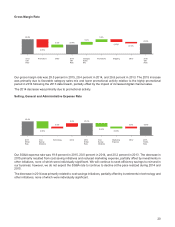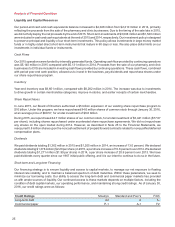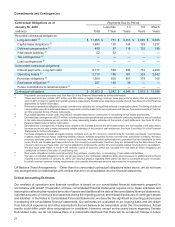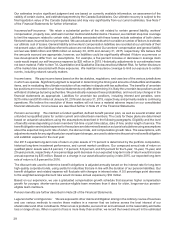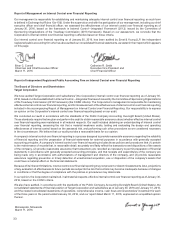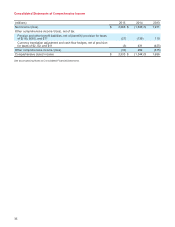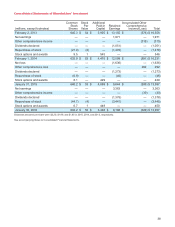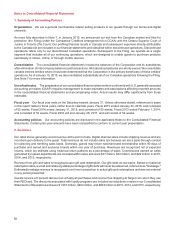Target 2015 Annual Report Download - page 34
Download and view the complete annual report
Please find page 34 of the 2015 Target annual report below. You can navigate through the pages in the report by either clicking on the pages listed below, or by using the keyword search tool below to find specific information within the annual report.
Our estimates involve significant judgment and are based on currently available information, an assessment of the
validity of certain claims, and estimated payments by the Canada Subsidiaries. Our ultimate recovery is subject to the
final liquidation value of the Canada Subsidiaries and may vary significantly from our current estimates. See Note 7
of the Financial Statements for further information.
Insurance/self-insurance:€€€€We retain a substantial portion of the risk related to certain general liability, workers'
compensation, property loss, and team member medical and dental claims. However, we maintain stop-loss coverage
to limit the exposure related to certain risks. Liabilities associated with these losses include estimates of both claims
filed and losses incurred but not yet reported. We use actuarial methods which consider a number of factors to estimate
our ultimate cost of losses. General liability and workers' compensation liabilities are recorded at our estimate of their
net present value; other liabilities referred to above are not discounted. Our workers' compensation and general liability
accrual was $498€million and $566€million at January€30, 2016 and January€31, 2015, respectively. We believe that
the amounts accrued are appropriate; however, our liabilities could be significantly affected if future occurrences or
loss developments differ from our assumptions. For example, a five€percent increase or decrease in average claim
costs would impact our self-insurance expense by $25€million in 2015. Historically, adjustments to our estimates have
not been material. Refer to Item€7A, Quantitative and Qualitative Disclosures About Market Risk, for further disclosure
of the market risks associated with these exposures. We maintain insurance coverage to limit our exposure to certain
events, including network security matters.
Income taxes:€€€€We pay income taxes based on the tax statutes, regulations, and case law of the various jurisdictions
in which we operate. Significant judgment is required in determining the timing and amounts of deductible and taxable
items, and in evaluating the ultimate resolution of tax matters in dispute with tax authorities. The benefits of uncertain
tax positions are recorded in our financial statements only after determining it is likely the uncertain tax positions would
withstand challenge by taxing authorities. We periodically reassess these probabilities, and record any changes in the
financial statements as appropriate. Liabilities for uncertain tax positions, including interest and penalties, were
$215€million and $195€million at January€30, 2016 and January€31, 2015, respectively, and primarily relate to continuing
operations. We believe the resolution of these matters will not have a material adverse impact on our consolidated
financial statements. Income taxes are described further in Note€23 of the Financial Statements.
Pension accounting:€€€€We maintain a funded qualified, defined benefit pension plan, as well as several smaller and
unfunded nonqualified plans for certain current and retired team members. The costs for these plans are determined
based on actuarial calculations using the assumptions described in the following paragraphs. Eligibility and the level
of benefits varies depending on team members' full-time or part-time status, date of hire, and/or length of service. The
benefit obligation and related expense for these plans are determined based on actuarial calculations using assumptions
about the expected long-term rate of return, the discount rate, and compensation growth rates. The assumptions, with
adjustments made for any significant plan or participant changes, are used to determine the period-end benefit obligation
and establish expense for the next year.
Our 2015 expected long-term rate of return on plan assets of 7.5€percent is determined by the portfolio composition,
historical long-term investment performance, and current market conditions. Our compound annual rate of return on
qualified plans' assets was 8.4 percent, 7.2 percent, 6.8 percent, and 8.5 percent for the 5-year, 10-year, 15-year, and
20-year periods, respectively. A one percentage point decrease in our expected long-term rate of return would increase
annual expense by $35€million. Based on a change in our asset allocation policy in late 2015, our expected long-term
rate of return is 6.8 percent for 2016.€
The discount rate used to determine benefit obligations is adjusted annually based on the interest rate for long-term
high-quality corporate bonds, using yields for maturities that are in line with the duration of our pension liabilities. Our
benefit obligation and related expense will fluctuate with changes in interest rates. A 0.5€percentage point decrease
to the weighted average discount rate would increase annual expense by $32€million.
Based on our experience, we use a graduated compensation growth schedule that assumes higher compensation
growth for younger, shorter-service pension-eligible team members than it does for older, longer-service pension-
eligible team members.
Pension benefits are further described in Note€28 of the Financial Statements.
Legal and other contingencies:€€€€We are exposed to other claims and litigation arising in the ordinary course of business
and use various methods to resolve these matters in a manner that we believe serves the best interest of our
shareholders and other constituents. When a loss is probable, we record an accrual based on the reasonably estimable
loss or range of loss. When no point of loss is more likely than another, we record the lowest amount in the estimated
29



